Hue Royal Tombs are extraordinary architectural works from the Nguyen Dynasty, epitomizing the pinnacle of construction artistry. Despite there being 13 kings, only seven tombs were constructed, due to political and economic factors. Each tomb showcases unique scale, architecture, and decorative artistry, making them popular attractions for visitors to Hue.
This article will provide you with an overview of the architecture and the beauty of Hue’s seven royal tombs!
When is the Best Time to Visit Hue Royal Tombs?
Hue’s royal tombs are a popular tourist destination, attracting many visitors from both domestic and international locations. Therefore, the question of the ideal time to explore these historical sites always receives special attention from tourists.
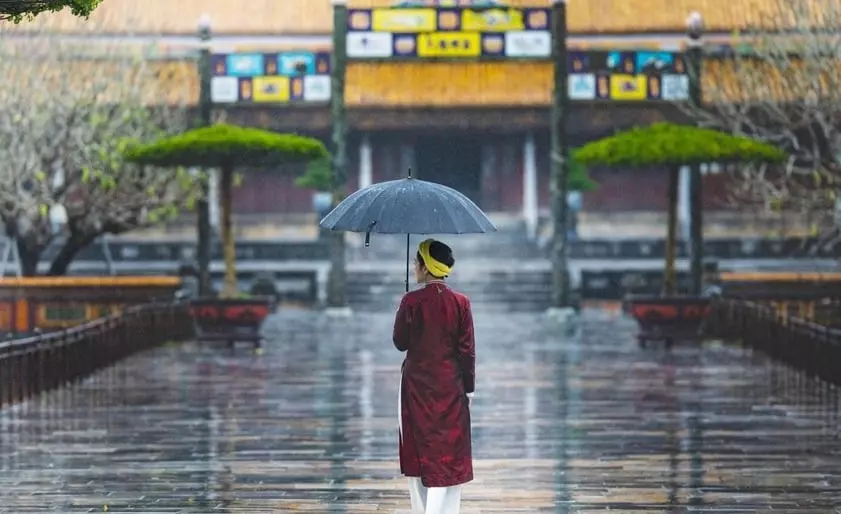
When introducing Hue, everyone mentions that this is a four-season tourist city. However, the best weather in Hue occurs in January and February. The climate during this time is very cool and pleasant. Therefore, you should plan your trip to Hue during this period to visit the famous historical sites in Hue, particularly the Hue royal tombs. Additionally, if you visit Hue in other months, you can refer to the article on the best time to travel to Hue to gain more insights and tips.
Must-Visit Royal Tombs in Hue When Traveling to the Ancient Capital
Tomb of Emperor Tu Duc – The Most Unique Tomb of the Nguyen Dynasty
Address: Thon Thuong Ba, Thuy Xuan Commune, Hue City
Entrance Fee: 100,000 VND/person/visit
The Beauty of the Tomb of Tu Duc
The Tomb of Tu Duc, also known as Khiem Lang, is considered the most beautiful of all the royal tombs in Hue. This tomb is surrounded by picturesque natural scenery, resembling a vast green park harmoniously integrated with nature.
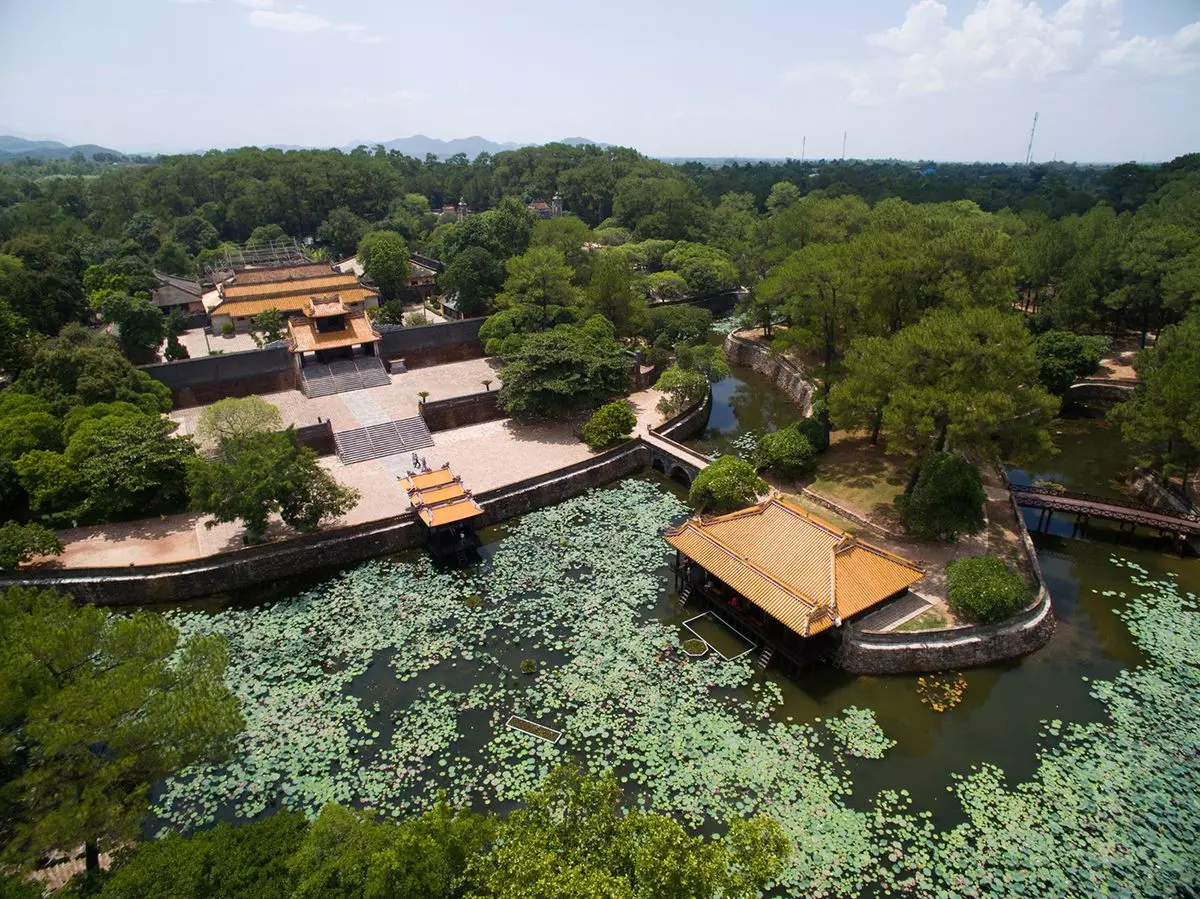
The beauty of the tomb is a perfect harmony that seems to blend into the natural surroundings, surprising visitors. Nestled among exquisite architecture are rolling hills, lush greenery, and tranquil ponds, all creating a serene atmosphere.
Visiting here, tourists can feel a sense of melancholy similar to the sensitive soul of Emperor Tu Duc, who had a deep appreciation for nature and poetry. He is known as a virtuous and filial king, praised by all.
Architecture of the Tomb
The Tomb of Tu Duc comprises nearly 50 structures built around the main hall and the tomb itself. It is one of the top tourist attractions in Hue. All constructions feature the word “Khiêm” (meaning “modest”): Minh Khiêm Đường, Khiêm Cung Môn, Cửa Vụ Khiêm, Xung Khiêm Tạ, điện Hòa Khiêm, and more.
The most notable structure in the architectural ensemble of the Tomb of Tu Duc is Minh Khiêm Đường. This is the only traditional theater among the tombs, holding significant value in decorative art and architecture. Additionally, Dũ Khiêm Tạ and hồ Lưu Khiêm are also masterpieces of national construction art, built in a pavilion style above the water surface.
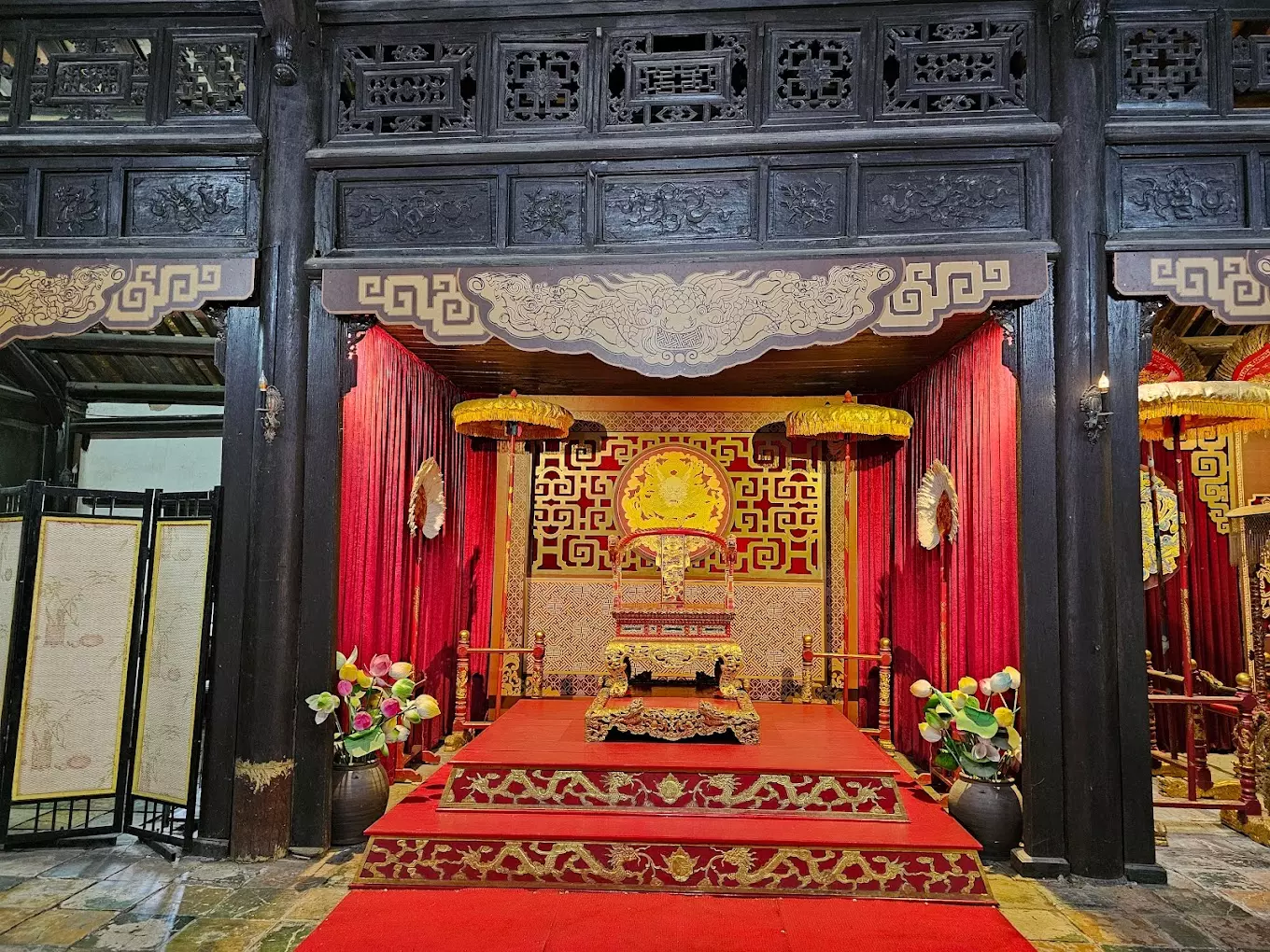
The Khiêm Cung Ký stele is another outstanding feature of the Tomb of Tu Duc. This stele contains 4,935 Chinese characters inscribed on both sides, making it the tombstone with the most text in the country to date.
With its stunning beauty and unique architecture, the Tomb of Tu Duc is an unmissable tourist attraction when visiting Hue.
Tomb of Emperor Minh Mang – Enchanting Architecture of Hue’s Royal Tombs
Address: Huong Tho Commune, Huong Tra Town, Thua Thien Hue
Entrance Fee:
- Adults: 100,000 VND/visit
- Seniors: 50,000 VND/visit
- Children: 20,000 VND/visit
The Beauty of the Tomb of Minh Mang
The Tomb of Minh Mang is situated on Cam Khe Mountain, at the confluence of the Huu Trach and Ta Trach rivers, which merge to form the Perfume River. This tomb was constructed in April 1840 and completed by Emperor Thieu Tri in 1943.
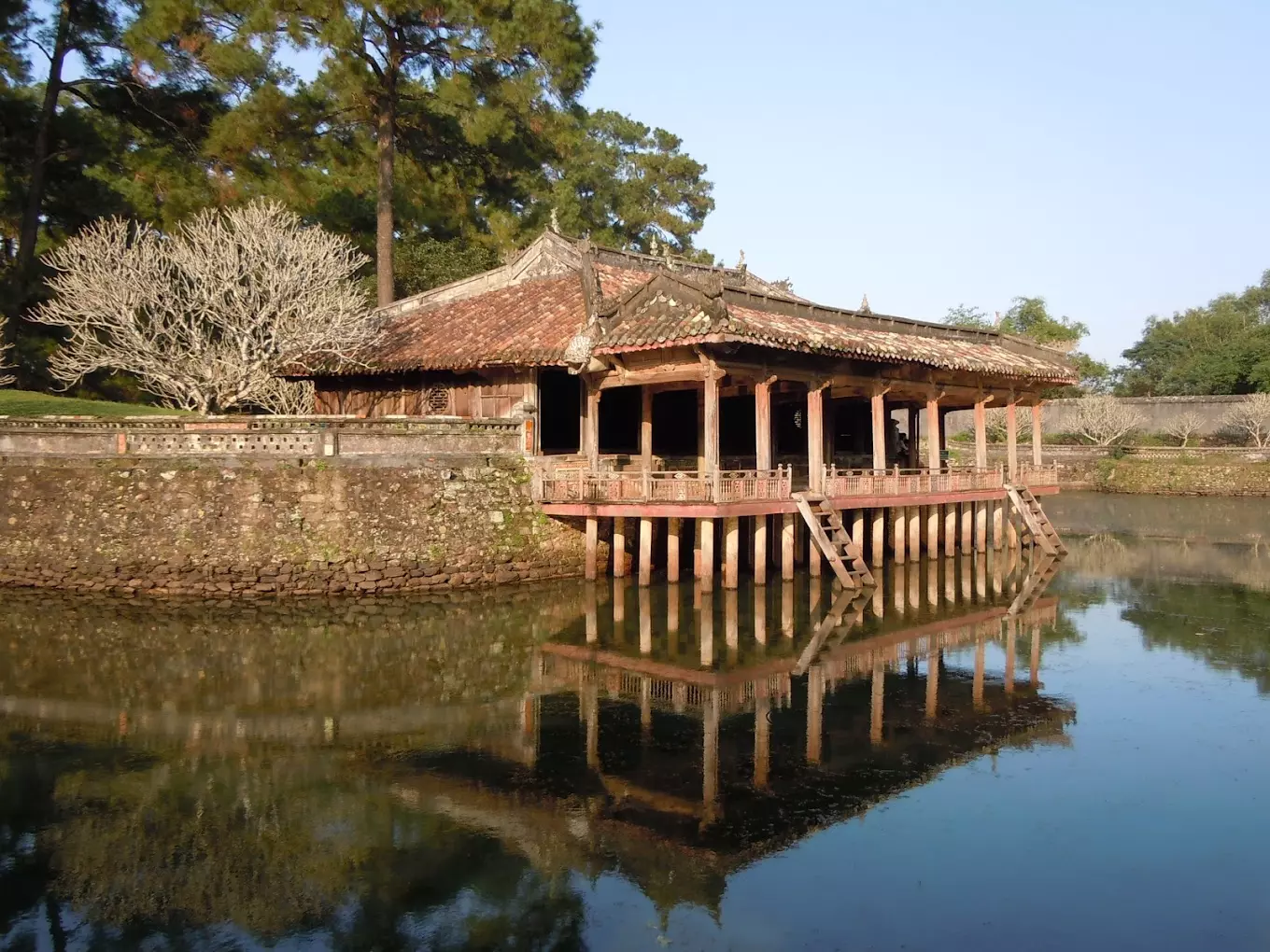
Surrounded by lush greenery, flowers, and serene ponds, the grandeur of the mountains, the picturesque lakes, and the melodious birds create a tranquil and beautiful natural landscape.
Visiting here, you will experience an expansive green space. The scenery at the Tomb of Minh Mang feels like stepping into a fairyland, providing an incredibly pleasant sensation.
Architecture of the Tomb
The Tomb of Minh Mang is regarded as the most majestic and standard royal tomb in the Nguyen Dynasty’s architectural system. The entire area of the tomb spans 1,750 square meters. Viewed from above, the tomb resembles a reclining figure resting comfortably.
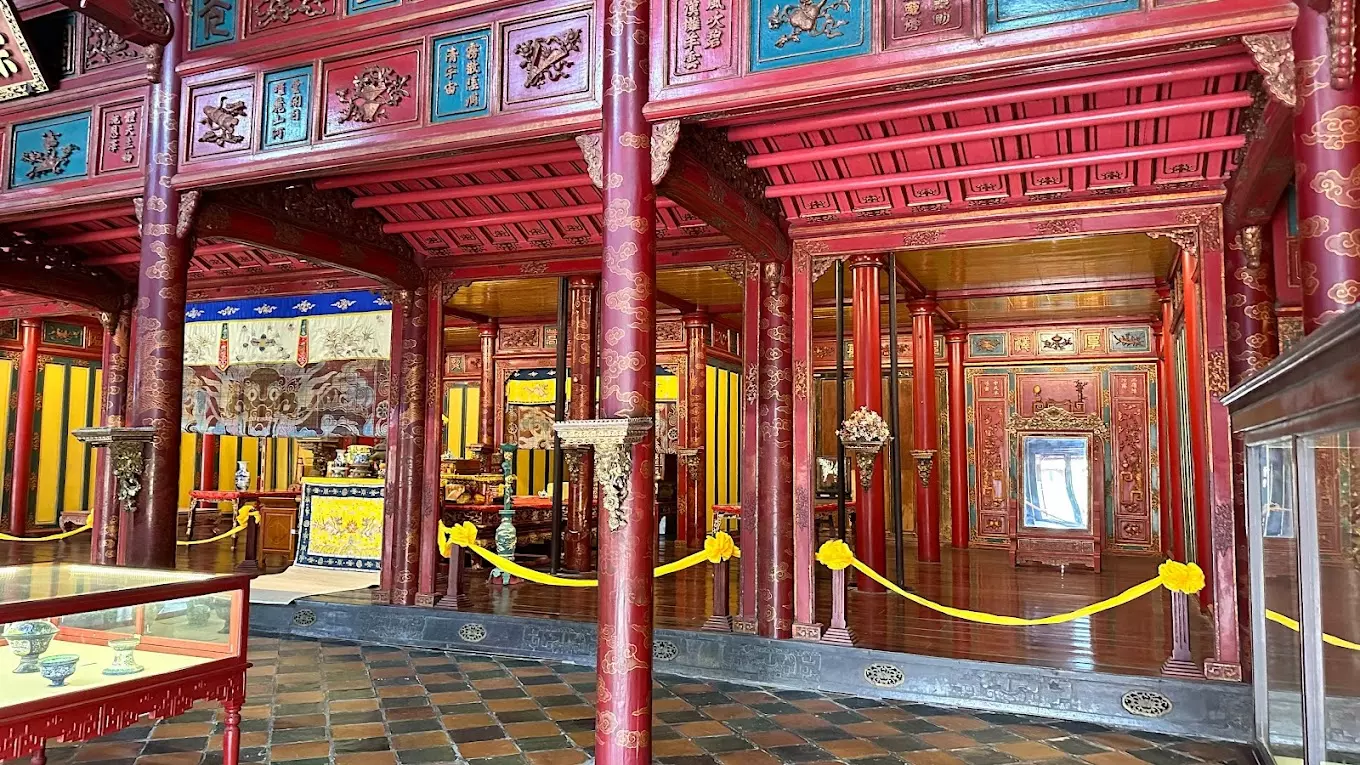
The overall architecture of the Tomb of Minh Mang comprises approximately 40 structures of varying scales, including: Đình Tạ (Pavilion), Lâu Đài (Castle), and Cung Điện (Palace). These structures are distributed along three large parallel axes, with the Thần Đạo (Sacred Path) serving as the central point.
Tomb of Emperor Khai Dinh – The Pinnacle of Hue’s Royal Tomb Architecture
Address: Châu Chữ Mountain, Thuy Bang Commune, Huong Thuy District, Thua Thien Hue
Entrance Fee:
- Adults: 100,000 VND/person
- Children (7-12 years old): 20,000 VND/person
- Children (under 6 years old): Free
The Beauty of the Tomb of Khai Dinh
The Tomb of Khai Dinh is located on a mountainside, providing a cool and airy climate. Upon arrival, visitors will be amazed by the numerous spectacular architectural works. The grandeur of the site will truly leave you in awe.
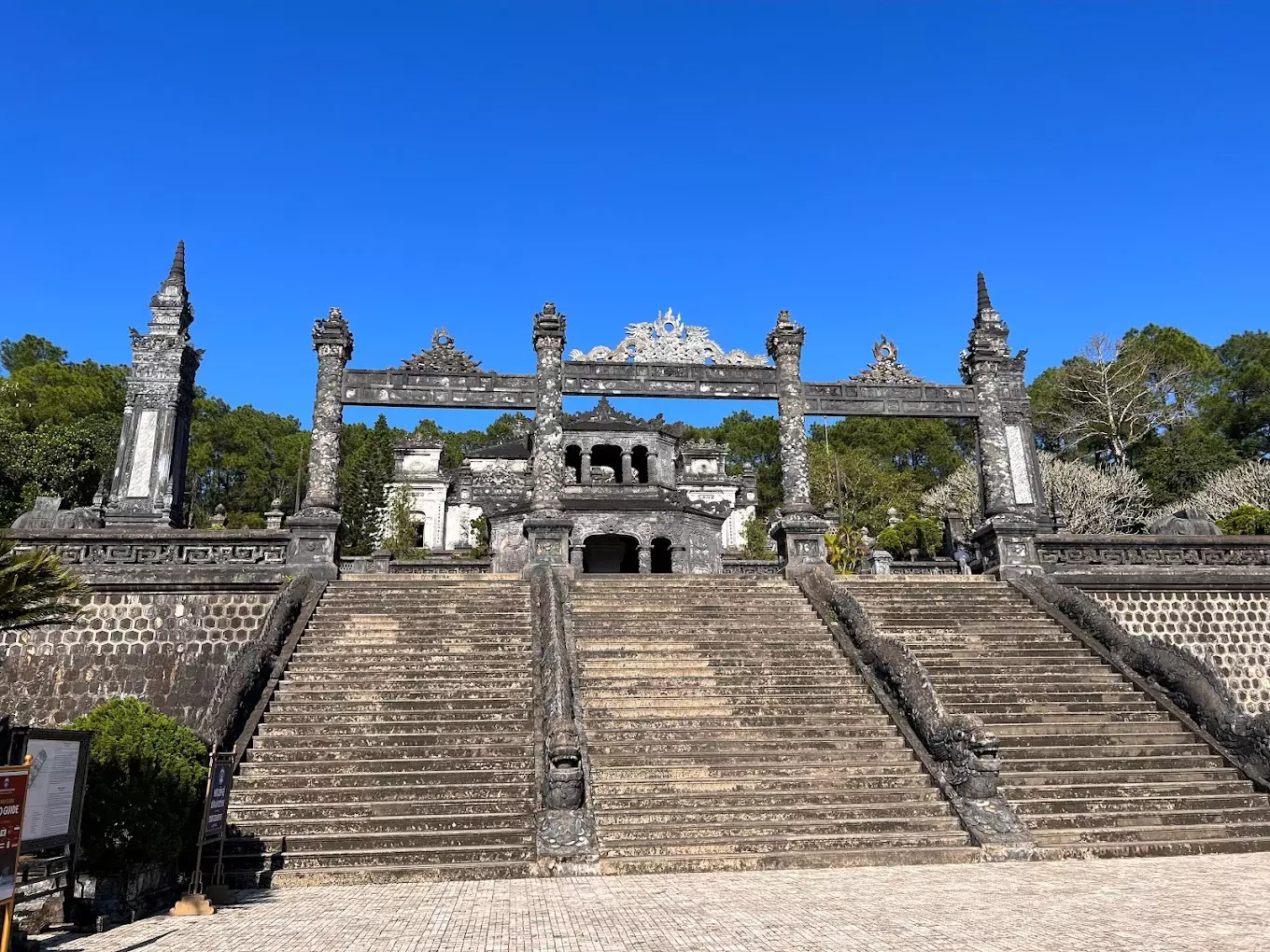
With its unique beauty that cannot be found elsewhere, the Tomb of Khai Dinh is also a perfect spot for stunning photos for any traveler. No matter where you stand, you can capture incredibly impressive pictures.
Architecture of the Tomb
When traveling to Hue, you cannot miss the Tomb of Khai Dinh, which features unique architecture. Although the Tomb of Khai Dinh is relatively small, it is the most elaborate and costly royal tomb among the seven tombs of the Nguyen Dynasty. Its architecture exhibits a distinct fusion of Eastern and Western cultures.

Overall, the Tomb of Khai Dinh has a rectangular structure with 127 steps and reflects various architectural styles, including Roman, Buddhist, Gothic, and Hindu influences. Notable features include the gate tower inspired by Hindu architecture, the stupa-like pillar heavily influenced by Buddhist design, a cross-shaped fence, and the stele house with octagonal columns and door arches built in Roman style.
Today, the Tomb of Khai Dinh continues to preserve high artistic values and has become a famous tourist attraction for many visitors exploring the dreamlike land of Hue.
Tomb of Emperor Gia Long – A Timeless Beauty of Hue’s Royal Tombs
Address: Định Môn Village, Huong Tho Commune, Huong Tra Town, Thua Thien Hue
Entrance Fee: 40,000 VND/person/visit
The Beauty of the Tomb of Gia Long
The Tomb of Gia Long is situated on the highest hill of Thien Tho Mountain, covered with pine trees. On your way to this historic site, you will encounter lotus ponds winding through the tomb’s architectural structures. During the lotus blooming season, the refreshing fragrance of these flowers fills the air.

The grounds of the Tomb of Gia Long are spacious but lack grand palaces or pavilions, and no walls were built around it. The surrounding hills spread out like giant hands, cradling the resting place of the king. The picturesque scenery has left many visitors in awe when they arrive here.
Architecture of the Tomb
The architectural complex of the Tomb of Gia Long is not as elaborate or majestic as some other tombs, but it exemplifies the pinnacle of feng shui art in construction. This architectural style helps the tomb maintain its pristine beauty.
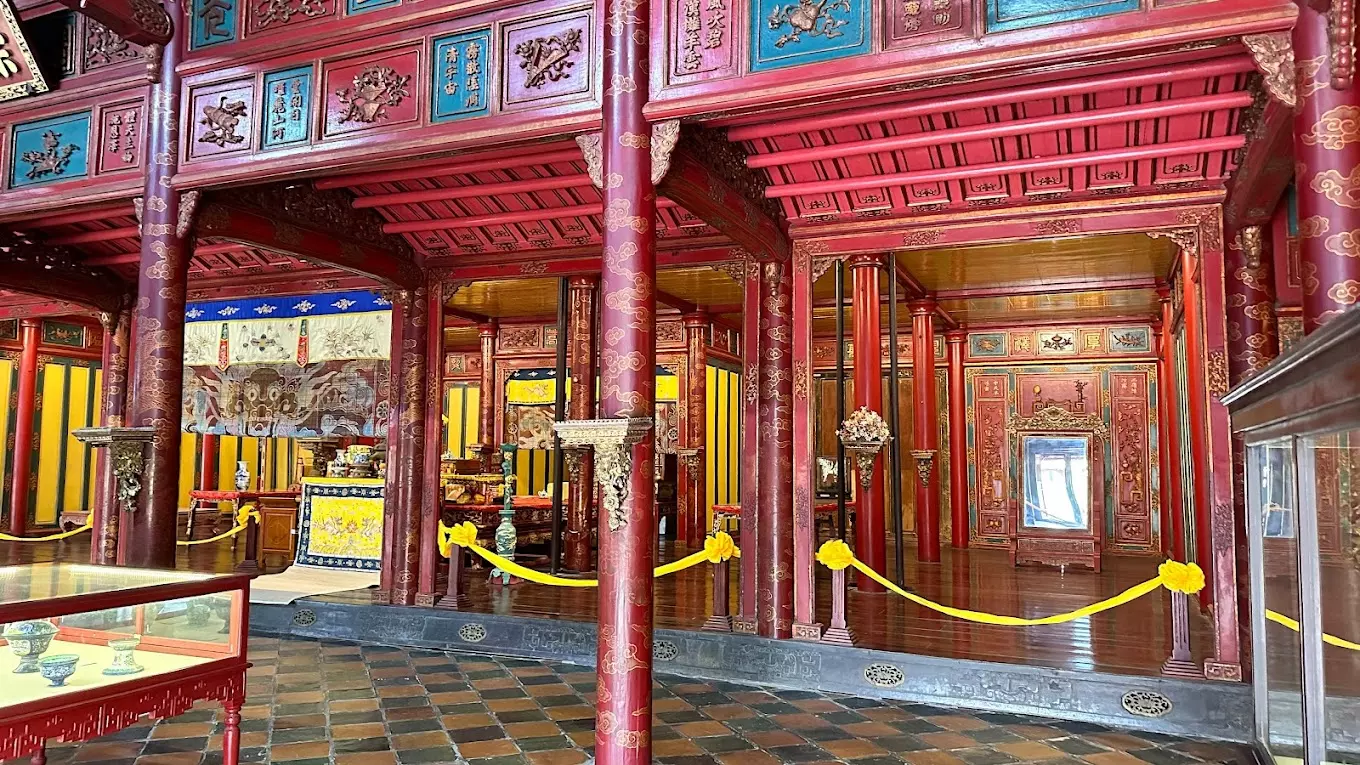
The overall layout of the Tomb of Gia Long is divided into three areas: the center holds the tomb of the king and Queen Thua Thien Cao, while the right side features the system of halls, with nearby tombs of the king’s relatives scattered throughout.
With its ancient beauty and impressive seclusion, missing the Tomb of Gia Long during your trip to Hue would indeed be a regrettable experience.
Tomb of Emperor Duc Duc – Simple Yet Elegant Architecture of Hue’s Royal Tombs
Address: An Cuu Ward, Hue City
The Beauty of the Tomb of Duc Duc
The Tomb of Duc Duc serves as the resting place for three emperors: Duc Duc, Thanh Thai, and Duy Tan. This tomb complex is situated at the foothills of Phuoc Qua Mountain, with Tam Thai Mountain providing a backdrop, and a small stream flowing in front, creating a harmonious landscape.

When you arrive here, you will experience a unique sense of tranquility. The overall scenery of the tomb is simple and unpretentious, providing a warm and welcoming atmosphere for visitors. At the Tomb of Duc Duc, you will have the opportunity to reflect on the glorious historical past of the nation.
Architecture of the Tomb of Duc Duc
The entire architecture of the Tomb of Duc Duc spans 6,245 square meters. The main structure is the Long An Palace—a double-building designed in the imperial style of Hue, adorned with intricate decorations. It is also regarded as a highly valuable wooden structure in terms of artistic merit.
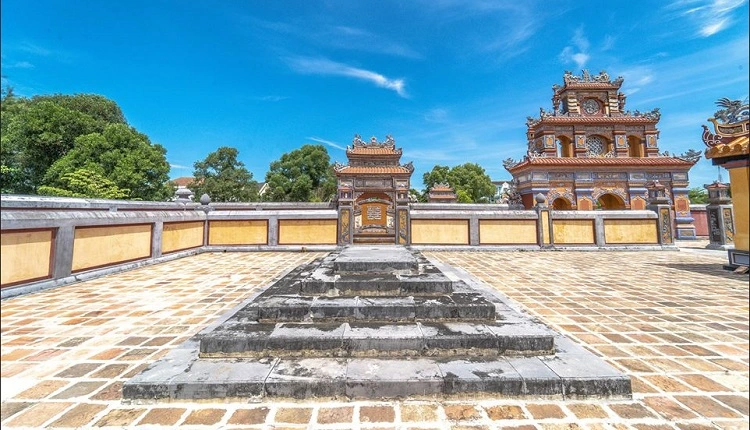
Tomb of Emperor Thieu Tri – The Serene Beauty of Hue’s Royal Tombs
Address: Thuy Bang Commune, Huong Thuy District, Thua Thien Hue
The Beauty of the Tomb
The Tomb of Thieu Tri is nestled against Thuan Dao Mountain. In front of the tomb lies a lush expanse of greenery and vast rice fields stretching from the Perfume River to Lim Bridge. This setting imparts a delicate, modest beauty to the tomb, allowing it to blend seamlessly into the expansive landscape of hills and mountains.
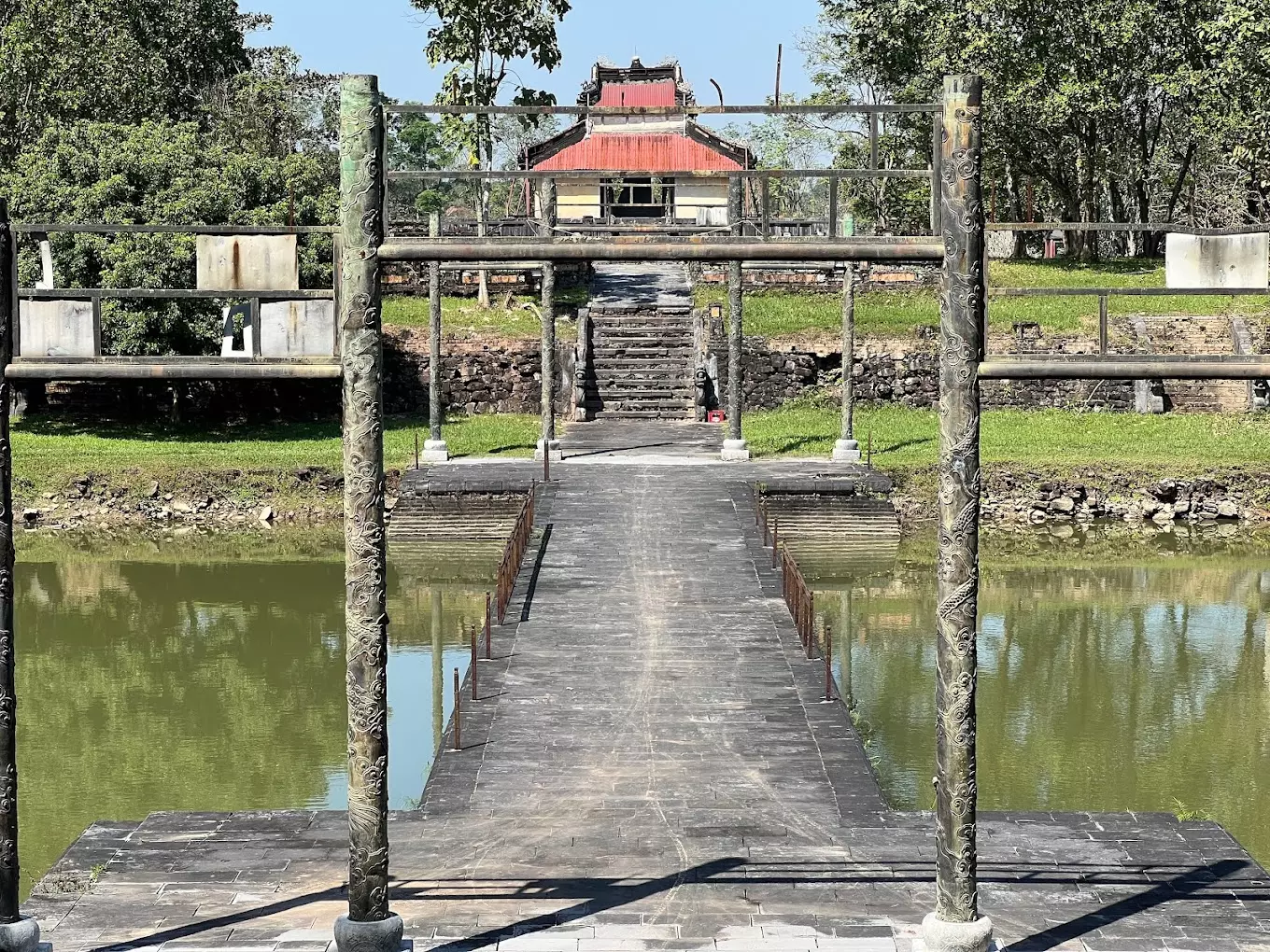
Visiting the Tomb of Thieu Tri, guests will experience a rare sense of tranquility and peace. The scenery here harmonizes with nature, making it an ideal destination for visitors to Hue.
Architecture of the Tomb of Thieu Tri
The Tomb of Emperor Thieu Tri combines two architectural styles from its predecessor tombs. It is also the only tomb designed to face the Northwest, a direction not commonly used in Nguyen Dynasty tomb architecture.

The tomb’s structure lacks walls, with separate areas for the tomb and private palace. It is divided into two sections: the tomb and the palace. The entire architecture is meticulously built, showcasing unique architectural values that remain significant to this day.
Tomb of Emperor Dong Khanh – Harmonious Architecture of Hue’s Royal Tombs
Address: Thượng Hai Village, Thuy Xuan Commune, Hue City
The Architecture of the Tomb of Dong Khanh
The architecture of the Tomb of Dong Khanh is divided into two areas: the palace and the tomb. In the palace area, the structures exhibit the design style of “trùng thiềm điệp ốc” (double-layered roofs). The main hall is adorned with red-painted wooden columns decorated with motifs of the four sacred animals and the four seasons.
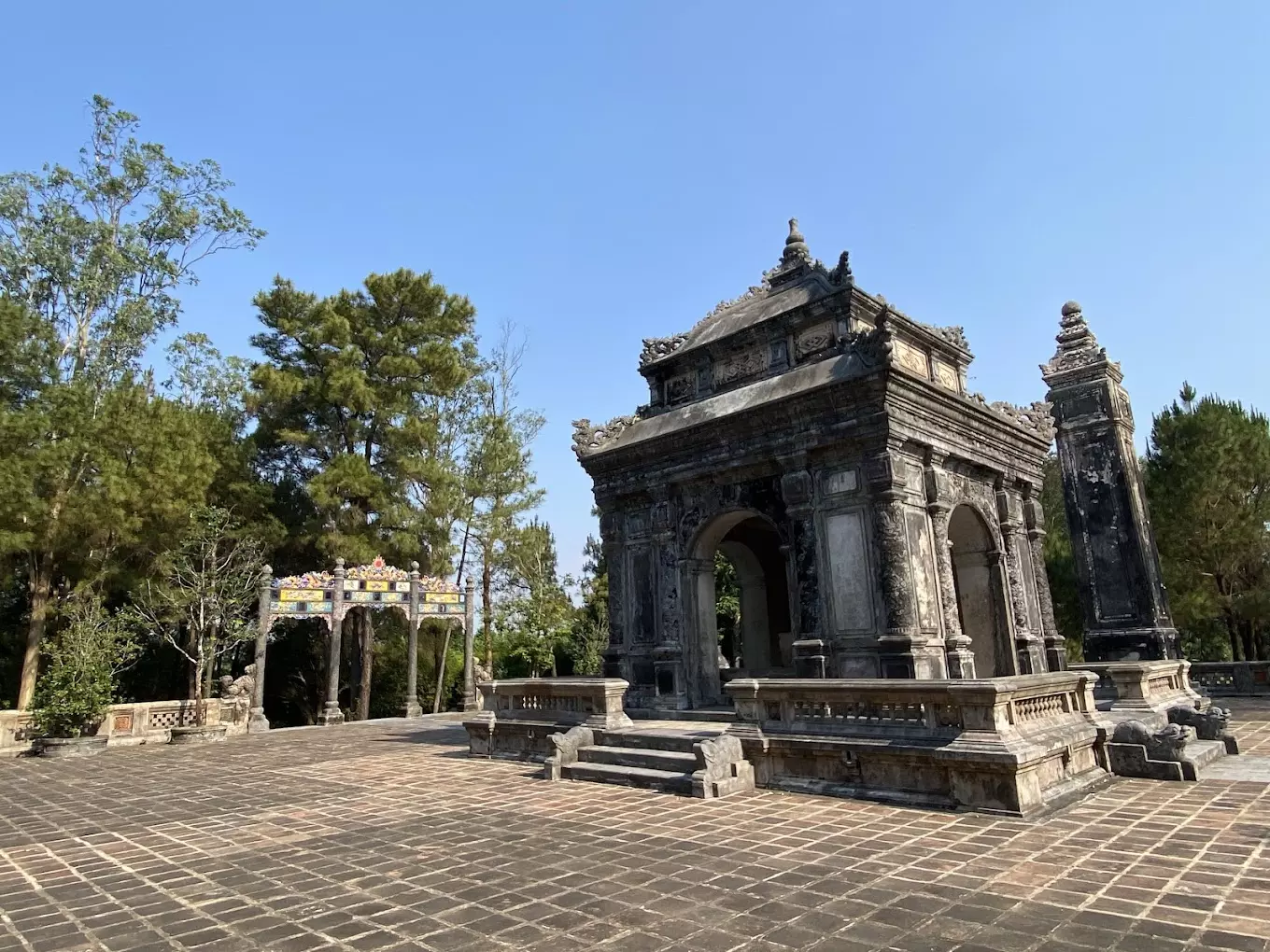
On the roof ridges of the Ngung Hy Palace, terracotta reliefs depict the Franco-Vietnamese War (during the Napoleonic era), reflecting the influence of Western culture in Vietnam.
The tomb area is predominantly influenced by European styles, from architecture to decoration and building materials. The statues of officials are tall and slender, made of cement and brick. The stele house represents a variation of the Romanesque architectural style.
Essential Tips for Visiting the Royal Tombs of Hue
When exploring the Royal Tombs of Hue, it’s crucial to be well-prepared to ensure a respectful and enjoyable experience. Here are some essential tips for your visit:
- Use Sunscreen: Since you’ll spend significant time outdoors, applying sunscreen is vital to protect your skin from harmful UV rays. Choose a high-SPF sunscreen and remember to reapply it regularly throughout your visit.
- Dress Modestly: As these are royal burial sites, visitors should wear respectful and modest clothing. Opt for elegant maxi dresses, long skirts, or traditional ao dai to honor the cultural significance of these historical sites.
- Bring Personal Belongings: Don’t forget essential items like identification, ATM cards, and cash. Having these items handy will help you navigate any unexpected situations during your exploration.
- Maintain a Respectful Attitude: When visiting the royal tombs, it’s important to exhibit courteous behavior. Speak softly and avoid using inappropriate language to preserve the solemn atmosphere of these sacred places.
Conclusion
To this day, the Royal Tombs of Hue retain their original artistic values in architecture, decoration, and sculpture that reflect the craftsmanship of the Vietnamese people. If you have the opportunity to travel to Hue, make sure to take the time to explore these unique tombs. Don’t forget to use the private car services in Hue from HueTransferService.com for a safe and comfortable journey while discovering the fascinating Royal Tombs of Hue!

